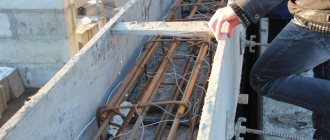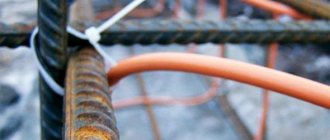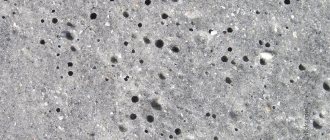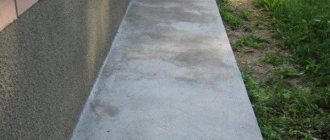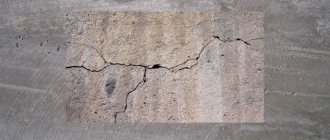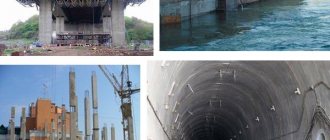Climatic conditions in most of the Russian Federation dictate their conditions for all types of construction and installation work that are carried out during the cold season.
In this regard, pouring concrete structures in conditions of negative ambient temperature is possible only if the construction site has the technical ability to warm up the poured structure, including using electricity.
On an industrial scale, concrete is heated using special transformers and heating cables. At home, for small volumes of concrete work, it is allowed to heat the concrete with a welding machine with a power of 150 to 200 Amps.
Preparatory work
The PNSV wire is cut into segments (heating loops) of 17-18 m. The resulting segments are evenly tied to the reinforcement frame for pouring the concrete structure. At the same time, make sure that the loops are located above the middle of the slab being poured; if a column is being poured, the layer of concrete above the heating loops should be at least 4 cm.
The garter is carried out with an insulated aluminum wire. The ideal option is if the loops are arranged “snake-like”. The distance between the loops is taken depending on the air temperature - from 10 to 40 cm. The rule here is “the lower the temperature, the shorter the distance.”
The number of heating loops depends on the power of the specific welding machine. Since one loop consumes 17-25A, in our case (power 250 A) no more than 7-8 heating loops with a length of 17-18 m can be used.
Important! When laying loops, the ends are marked - one end is marked with electrical tape, the second is left free.
The loops are laid and tied. Now it is necessary to extend aluminum wires onto them, which will be connected to the welding machine. The length of the aluminum wire is determined by the location of the welding machine, but not more than 8 meters.
I insulate the twists of the heating loop and the extension wire with CB electrical tape, and place it in such a way that it remains in the thickness of the structure being poured. Otherwise, the twist will overheat and burn. The markings are applied with electrical tape to the ends of the aluminum wires.
Low frequency transformer and concrete
Principle of operation
To fill monolithic structures at temperatures below -4? C, they resort to various methods of heating the cement mass, these are infrared emitters, heated mortar, warm formwork, and anode heaters. But the most effective and economical is heating the concrete using a low-frequency transformer and PNSV wire (Heating Wire Steel Vinyl Insulation).
Before connecting the transformer to heat up the concrete, loops of PNSV wire with a cross-section of 1.2 mm2 to 3 mm2 are laid on the reinforcement frame. This cable is capable of warming up to a temperature of 80? C, thus heating the solution to 40? C-50? C, and all this happens at an air temperature of -4? C and below. In order to achieve the most optimal heating of concrete in frosty conditions, about 60 m of PNSV-1.2 is needed per cubic meter of solution.
When laying the loops, be careful not to close the circuit; in other words, when you tie the wire to the reinforcement frame, its insulation (PNSV) can simply rub against the metal and the loop will burn out. Under such conditions, a certain area of the pour will remain without heating, which can lead to destruction of the unspecialized mass and, as a result, the reinforced concrete will be of poor quality (see also the article “Painting a cement fence: how to get a durable coating”)
For warming up, the instructions allow the use of transformers such as KTP-06-20, KTPTO-80, KTP-OB-160, TSDZ-63 and even then.
Oil transformer. Characteristics
| Transformer | KTPTO-80 | KTP-63-OB |
| Rated power (kVA) | 80 | 63 |
| HV voltage (V) | 380 | 380 |
| No-load voltage CH (V) | 49, 60, 70, 85, 103, 121 | 49, 60, 70, 85, 103, 121 |
| MV side current at voltage | 660 (49-70V, A) | 520 (49-70V, A) |
| MV side current at voltage | 382 (85-103-121V, A) | 301 (85-103-121V, A) |
The transformer is dry. Characteristics
| Transformer | TSZ-20 |
| Rated power (kVA) | 20 |
| Nominal frequency (Hz) | 50 |
| Number of phases | 3 |
| Nominal winding voltage, transformer HV, LV V | 380/220 12,4; 24,8; 49,7;66,0 |
| Rated current of HV winding of transformer A LV | 30,4/52,6 465;375; 235;175 |
| No-load current (%) | 7,5 |
| Connection diagram/group | Star/delta |
| Circuit loss (W) | 400 |
| No-load loss (W) | 200 |
Preparing for work and launching
In order to more clearly imagine the connection cycle and operational start-up, below will be given instructions for the transformer for heating concrete KTPTO-80 (see also the article “Cement panels for fences - advantages and installation”).
All work on heating the poured concrete should be done in compliance with SNiP 111-4-80/chap.11 and GOST 12.1.013-7, which regulates the procedure for performing work and electrical safety.
First of all, the KTPTO needs to be zeroed, and this can be done by connecting the power cable (its fourth core) to terminal N of the XT6 block, thus connecting all this to the iron control cabinet. The transformer is grounded from the slide - there is a special bolt for connecting the circuit, and a steel wire of at least 4 mm is used for the connection
Before connecting the step-down transformer to the network, you need to check the insulation resistance with your own hands, which should not be less than 0.5 MOhm, and pay attention to the tightness of the contact connections. Position switches SQ1 and SQ2 must be installed so that when opening the cover of the transformer casing and control panel it is possible to reliably close contacts SQ1 and SQ2
In addition, it is imperative to check the fuses in case of a short circuit. We set the power transformer switch to 55V, which will correspond to position 1, and set the involuntary switch together with switch SA3 to the “OFF” position. Then the heating circuit installed in the formwork can be connected to the power cable, which, in turn, is connected to the HTB clamp block.
- We supply 380V power to the KTPTO input and turn on QF1 after checking the voltage according to HL1 and HL3 and then, using the emergency shutdown button SB1, we do a control shutdown, after which we start QF1 again. We supply power to KL1 with the SB3 button, after which the magnetic starter KM1 should operate.
- To switch operating modes, you need to lift the cover of the transformer casing and then QF1 will automatically turn off through the contact switch SQ1. Upon completion, switch the voltage levels and turn on QF1 and KM1.
Connection to the welding machine and heating features
After pouring the concrete, all aluminum ends (extended) of the loops are connected to the welding machine. In this case, the ends marked with electrical tape and without it are connected to different poles of the welding transformer. Turn on the welding machine at the minimum load of the power regulator.
They check each of the loops with pliers - the current consumption should be no more than 12-14 Amperes. After 1 hour, you can add half the power of the device, and after 2 hours you can turn on the device at full power.
Again we check the current strength in each loop. The current strength should be no more than 25 A. As practical experience says, a loop power of 20 A is enough to efficiently heat the concrete at an ambient temperature of minus 10 °C.
Principle of operation
A step-down transformer for heating concrete is a device that provides power to electrodes or a heating cable from a single- or three-phase network. It is enclosed in a steel casing, and is equipped with cooling systems, automatic control and a control panel.
Alternating current from the network is supplied to the high-voltage coil, according to the law of electromagnetic induction through the magnetic circuit, it excites a low-voltage EMF in the secondary low-voltage coil, which withstands high currents. Heating electrodes or a special heating cable are connected to the terminals.
The control unit regulates the output power required for normal operation of the electric heating system when the air temperature changes. A fuse is installed in front of the high-voltage coil; it will be needed to turn off the equipment if the heating transformer for concrete is overloaded, or if there is a risk of a short circuit. To monitor the operation of the low voltage coil, an ammeter is included in its circuit.
The connection of a transformer and the operation of the entire system is based on the property of a conductor to generate heat when current passes through it. First, the formwork is installed, in which the reinforcement frame is welded. Then the PNSV heating wire with a cross section of 1.2 mm is laid out on it, although there are other options, but this one is cheap and practical. The cold ends are brought out, after which the construction mixture is poured and compacted.
After pouring the solution, the cable is connected to a station (transformer) for heating the concrete, and warms it up to 80ºC at a speed of no more than 10ºC per hour. In this case, the heating time of the concrete mixture depends on the ambient temperature. The ammeter of the low voltage winding all this time shows a current of 14-16 A. After reaching the maximum temperature, it is lowered to 40ºC by no more than 5ºC per hour and held until the monolith reaches critical strength.
When heating with electrodes laid as reinforcement, the heating principle is similar to wired systems. The structures, which are electrodes, are connected to the transformer through a special cable. During operation, monitor the current in the low-voltage winding, since as concrete hardens, the electrical resistance increases and the current decreases.
Features of heating concrete with a welding transformer
- Warm-up time depends on the power of the structure and the ambient temperature. At air temperatures down to minus 10 °C, two days are enough for concrete to hydrate;
- The surface of the concrete structure must be insulated with drinkers or mats;
- You should not overheat the concrete - the structure under the insulation layer should be slightly warm and nothing more.
When the temperature of the concrete is less than +5 degrees Celsius, then to warm it up I use special three-phase step-down transformers of the air or oil type. But they are more suitable for small volume work. If heating is required when pouring a foundation in a country house or for other relatively small buildings, then the concrete can be heated with a welding machine, the connection diagram of which will be slightly different from the usual one. Low-power devices here turn out to be more convenient than professional equipment. They are more economical and mobile, not to mention accessible.
Read also: How to make a musket from wood
If we look at everything in general terms, the heating scheme here remains virtually unchanged, since the main difference lies in the power of the equipment used. But to fill a slab with an area of 5x4 meters, a 250A welding machine is sufficient. This interchangeability is due to the fact that the transformer in the welding machine and the ordinary one used for step-down perform practically the same functions, only for different purposes.
Heating modes for concrete electrodes
When choosing modes, there are a number of factors to consider, including:
- Dimensions and geometric design features.
- Brand of concrete.
- Operating conditions of the building.
In modern construction, the following schemes for heating concrete with electrodes are practiced:
- 2 stages: heating of concrete with isothermal exposure;
- 2 stages: heating of the structure, followed by cooling and thermal insulation exposure (even when using this scheme, you can install a heating formwork);
- 3 stages: involves heating, isothermal holding and cooling of the material.
Regardless of the method used, it is necessary to monitor the temperature values and start work at +5 ℃, gradually raising the temperature at a frequency of 8-15 ℃ per hour. Acceptable values are +55…+75 ℃. To prevent deviations, it is necessary to measure the temperature regularly.
The duration of isothermal exposure is selected taking into account laboratory analysis of compressive strength. The exact information depends on the type of cement, heating temperature and expected strength of the material.
Cooling of concrete is allowed at a rate of 5-10 ℃ per hour. As at the concrete heating stage, here it is necessary to take into account the volume of the structure and its purpose.
What is needed to heat concrete?
- First of all, you need a transformer itself, which can be used at home. On average, this is a technique with a maximum limit of 200-250 A.
- It is also necessary to have a PNSV wire. For the procedure, it is advisable to cut it into several pieces of the same length.
- Aluminum single wire. It is advisable to choose its cross-section within the range of 2.5-4 mm square.
- For insulation, simple cotton tapes are suitable, which are precisely produced for such purposes.
- Current clamps.
- Pliers.
Warming up concrete with a welding machine using PNSV wire
The heating wire is cut into pieces of 18 meters. The number of sections required depends on the power of the welding transformer that will be used. The calculation of the quantity is determined based on the fact that one piece of wire can withstand 25 A. But if your device has a maximum current of 250 A, this does not mean that it is worth taking 10 pieces. It is better to operate in medium mode at 200 A and use 8 parts. This amount is sufficient for a slab of 20 cm and an area of 5x4 meters.
Aluminum wires are connected to the existing PNSV wires. The connection is made by twisting, and the length of the wire is selected locally, since its ends will need to be connected to the welding cable. All twists must be insulated.
After this, warm-up loops should be installed. The cable should be above the middle of the slab, but not reach the top layer in the reinforcement. The loops are tied with insulation to prevent them from shorting. To prevent the twist from burning, it must be in concrete. The aluminum ends are led out of the pouring area. It is advisable to mark all exits to avoid confusion.
Once the concrete is poured, the heating circuit should be assembled as quickly as possible. To do this, you need to connect two cables from the welding machine. Thus, there should be 8 ends for each welding cable. After this, you can turn on the welding machine to heat up the concrete. Before starting work, you should reduce the number of Amps on the regulator. If after switching on the current value turns out to be too high, then do not worry, since during warming up it will decrease. If the value drops to the point where the current becomes too weak, then it is worth increasing the value after that. This happens a few hours after switching on. Periodically, you need to check the load so that it does not exceed 25 A. The entire process can take more than a day, therefore, welding inverters with low duty cycle are not useful for this operation.
Heating concrete with a welding machine and electrodes
Special electrodes are used for this process. The first variety is lamellar. They are installed on the inside of the formwork, which improves contact with the mixture. An electric field heats the concrete to a predetermined temperature.
There are also strip electrodes, the total width of which reaches up to 45 cm. They are mounted on both sides, and when connected to a transformer, the field between them heats up the concrete mixture.
Strings are used when heating cylindrical structures such as columns. In this case, the electrode itself is placed in the center of the structure, and a conductive sheet runs along the outside.
Rods externally resemble reinforcement, since their diameter is 7-11 mm. They are placed inside the concrete with a certain step. The last products in the row are placed up to 40 cm from the formwork. This type is used for complex structures. Thus, for each type of work it is necessary to choose its own types of electrodes.
The technology for their use is as follows:
- The products are laid out evenly over the entire surface of the concrete site;
- Then they are all connected into two separate circuits, one of which will be “+” and the second “-”;
- An incandescent lamp is installed between them, which helps to monitor the voltage;
- The circuits are connected by feedback and forward connection wires.
Read also: How to properly install a cutter on a lathe
To prevent moisture from evaporating from the surface quickly enough, it needs to be covered with a layer of sawdust. You can control the temperature using an ordinary thermometer.”
Conclusion
Home welding machines are great not only for welding at home, but also for other procedures where ultra-high power is not needed. Heating concrete with a transformer is a clear example of this. One of the few things you will have to acquire to carry out such an operation will be special electrodes. Measuring instruments should already be in the welder’s arsenal. But here care should be taken to ensure that the work is carried out safely so that the operating modes do not exceed the permissible characteristics of the equipment. Otherwise, this may lead to equipment failure.
Construction work on the construction of facilities is carried out year-round. Often builders carry out concreting to form solid structures in the winter. It is important to ensure the strength of the monolith and prevent water crystallization. When heating the concrete, it is important to maintain the required temperature of the mixture and create favorable conditions for cement hydration. Let's focus on heating technology based on the use of infrared rays and electricity. Let's look at the advantages and disadvantages of each method.
The most common problems when operating equipment for heating concrete
As a result of natural wear and tear, which occurs even if the units are used correctly, breakdowns occur, the most typical of which are:
- Failure of the oil transformer switch. Such a switch is located in an oil environment, so repairing or replacing it requires a complete stop of the device and drying it after draining the oil.
- Short circuit of windings. The consequences are burnout of the AV and wires located in the cabinet.
- Failure of busbars in the control cabinet. This may occur due to unprofessional cable connections.
The following problems may occur in dry-type transformers:
- Failure of cooling system fans.
- AB malfunction.
- Failure of monitoring, measuring, and control devices.
It is advisable to entrust the current and major repairs necessary to restore the functionality of transformers for heating concrete to the professionals of service centers equipped with modern diagnostic and repair equipment.
What methods are used to heat concrete in winter?
Faced with the need to carry out concreting in difficult climatic conditions, builders take measures to maintain the temperature of the mixture that meets the requirements of the technology. Concrete containing water hardens under standard conditions within four weeks. What is the right thing to do? After all, moisture at negative temperatures crystallizes, increasing in volume, and can cause the formation of cracks.
To ensure a favorable temperature, the following methods are used:
- electric heating, for which a PNSV wire is used. The cable is laid inside the structure and concreted;
- electric heating using a transformer for welding. Voltage is applied to the wire for heating the concrete through steel rods;
- formwork heating of concrete mass. Panel elements of prefabricated formwork contain electric heaters;
To choose the optimal heating method, you should make calculations and analyze all the nuances. It is necessary to take into account the possible level of costs and only then give preference to a specific method. Let's consider the specifics of each method.
How does construction proceed in winter?
Winter is a period of low temperatures, so how does the construction of complexes of concrete structures take place at this time? After all, it is known that concrete is a mixture of gravel, sand, cement and water in a certain proportion. And the time during which the solution gains design strength is 28 days. We also know that when water freezes, it occupies a larger volume and can tear apart monolithic structures.
There are several ways to get around the temperature limitation, but they all boil down to one thing: maintaining the temperature of the solution above zero. If this standard is not observed, the erected structure will not be strong enough and will collapse very quickly. Below we will provide several popular methods for heating concrete at a construction site in winter.
We connect the wire for heating the concrete PNSV
By using a heating cable for concrete, you can achieve a positive temperature of the mixture in the winter months. The method of performing the work is simple. A cable marked PNSV should be laid in the structure to be concreted and supplied with supply voltage from an electrical energy source.
This heating method is often preferred due to its serious advantages:
- increased efficiency. A correctly laid heating cable, which is selected by calculation, can maintain the temperature necessary to harden a significant volume of concrete;
As a rule, power supply to PNSV cables is carried out through substations with several stages of reduced voltage
- efficiency. Electrical energy consumption is acceptable. This allows you to invest in the estimate of construction activities and prevent overspending;
- preservation of the concrete structure. When connecting the wire to a source of electrical energy, cracking of the concrete mass and the formation of air pores in it are excluded;
- versatility. Electric heating technology can be used for solid building structures that are made of ordinary or reinforced concrete.
Along with undeniable advantages, the technology also has weaknesses:
- requires preparatory work during which the wire is laid. The flexible cable for heating concrete requires care when placed in a reinforced structure and is laid according to the drawing;
- requires the use of a step-down transformer. The technical characteristics of the equipment for reducing the supply voltage should allow for smooth adjustment of the heating of the concrete mixture in the required range.
A specially designed wire is used, which consists of the following elements:
- conductor;
- protective insulation.
Cable selection is carried out after performing calculations taking into account the following parameters:
- transformer output voltage;
- cross-section of the conductive part;
- total length of the laid cable.
The temperature of the structure should not fall below the technologically determined minimum
When performing work, observe the following recommendations:
- lay the wire on a clean surface, avoiding damage;
- form cable loops evenly, avoiding kinks.
Read also: DIY plywood models, drawings
When purchasing PNSV wire, check the product’s compliance with the certificate. The reputation of the cable manufacturer plays an important role. The technology of using wire to heat a concrete mixture has much in common with the method of forming a heated floor.
How concrete is heated using a welding machine
The technical characteristics of the welding transformer allow it to be used for heating the concrete mixture. The device regulates the current supplied to the electrodes.
The equipment is used in the production of the following structural elements of buildings in winter:
- support columns;
- capital walls;
- various fences.
The supply voltage is supplied to the following conductive elements:
- reinforcing bars;
- wire with a cross section of 0.6–0.8 cm;
- steel plates.
Perhaps the most common heating method is passing an electric current through the concrete using electrodes.
Work technology:
- Stick the electrodes into the liquid mixture.
- Apply voltage and adjust current.
When heating small-area vertical structures, you can use one conductive rod. In this case, the voltage from the transformer is supplied to the reinforcement frame and a steel bar inserted into the solution.
To ensure that warm-up is effective, follow these guidelines:
- immerse the electrodes at intervals of 0.8–1 m;
- smoothly regulate the current to ensure the required temperature.
Advantages of the technology:
- ease of implementation;
- Possibility of application at various sites;
- quick installation and connection.
Disadvantages include:
- increased electrical energy consumption;
- costs associated with the inability to reuse electrodes.
When performing work, it is important to comply with safety requirements.
Using such electrodes, you can heat structures of any shape, even the most complex ones.
Electric heating of concrete using special formwork
To ensure a positive temperature of the hardening concrete mixture, builders also use prefabricated panel formwork. Its peculiarity is the equipping of standardized panels with quick-detachable electric heaters.
Advantages of use:
- accelerated dismantling of electric heaters. The design provides easy access for replacement and maintenance;
- versatility. The formwork is assembled from individual elements with standard dimensions and can be used repeatedly;
- efficiency. The formwork allows you to heat an increased volume of concrete at temperatures down to -20 degrees;
- increased efficiency of use. Increased profitability and low cost are characteristic of this method;
- quick assembly of the structure. Accelerated assembly of formwork elements allows you to reduce installation time.
Along with the advantages, there are weaknesses:
- increased price of formwork;
- impossibility of use if the object has a curved shape.
Panels with heaters are used in the construction of large objects.
Installation of the heating system is carried out immediately before pouring the solution into the formwork
Infrared heating of concrete
Infrared rays allow for targeted heating of a concrete mass to a predetermined temperature. The strength of radiation and the depth of heating vary depending on the distance between the infrared heater and the surface of the concrete mass.
Method of heating using thermomats:
- Additives are added to the concrete mixture to accelerate hardening.
- Special infrared mats are laid on the surface of the array.
- The power cable is connected and electrical voltage is applied.
The technology allows heating of concrete structures located in a horizontal position.
Advantages of this method:
- low power consumption;
- ease of implementation;
- heating intensity control;
- possibility of heating concrete through formwork panels.
Weak sides:
- accelerated evaporation of moisture from the concrete mixture, which needs additional protection from drying out;
- increased costs associated with the purchase of thermomats for heating an increased space.
Despite its shortcomings, the infrared method is in demand in the construction industry.
This method is especially often used when screeding in winter.
Using a preheated solution
The method of heating the concrete mixture before performing concreting work is the simplest. The technological algorithm provides for the following operations:
- heating the concrete solution at the stage of mixing the components;
- pouring the heated mixture directly at the work site.
For the practical implementation of this technology, special calculations are made aimed at determining the operating temperature.
This takes into account:
- amount of concrete poured;
- time for transportation and filling;
- ambient temperature.
In case of deviations in the calculations, additional heating is carried out using any of the known methods.
Operating principle of the device
When the ambient temperature drops below + 4 0 C, additional heating is required to work with concrete solutions. Currently, there are many ways to work with material in winter.
Such methods include, for example:
- heating using infrared rays;
- insulation of formwork.
However, they are all quite expensive. Therefore, it can be called the most economical and effective.
The photo shows a diagram of the heating wire placement
The actions of such a mechanism are quite simple:
- For operation, the transformer itself and wires are required, and their length is selected for each object separately.
- The latter, on one side, are connected to a frame made of reinforcement, and on the other, they are brought to a substation for heating the concrete.
- When electric current passes through wires, their temperature can rise to +80 0 C.
- After this, the heat released during heating is distributed throughout the entire volume of the concrete mixture
. As a result, in winter it can warm up to temperatures of +40-50 0 C.
The most effective for this process are wires with a steel core thickness of 1.2 or 3 mm. At the same time, there is a separate group specially made for heating concrete mixtures (PNSV-1,2).
When calculating the required number of wires, you should remember that 1 m 3 of the mixture takes about 60 m; the price depends on the cross-section and number of wires.
For such purposes, the following types of transformers are used:
- KTP-OB (20.60 and 160);
- KTPTO-80.
One such device is capable of heating a concrete mixture with a volume of 20-30 cubic meters.
Requirements before the heating process
The wire for heating the concrete mixture is laid with your own hands on the reinforcement frame itself, as well as between them, immediately after they are laid in the formwork. In this case, it is not recommended to tighten the wires ().
Plastic insulation must be provided for the wire coming from the transformer. Moreover, this wire should be 2-3 times thicker than that used in the concrete mixture.
